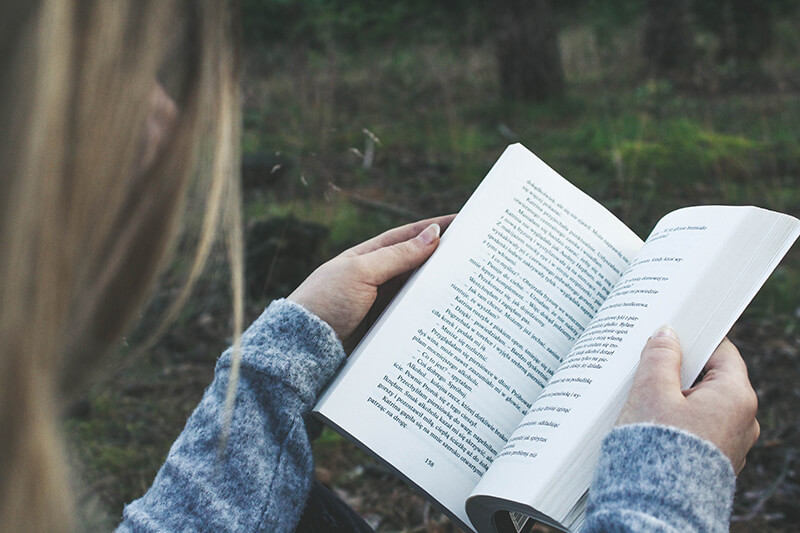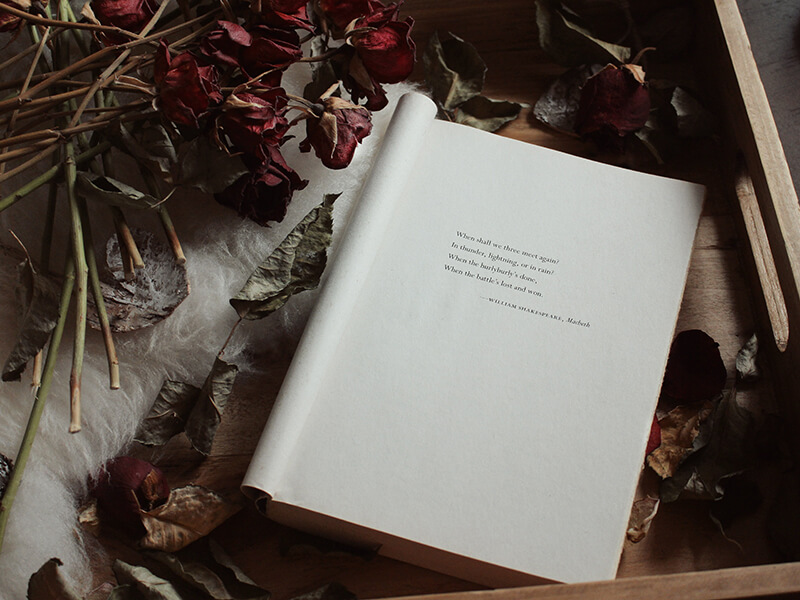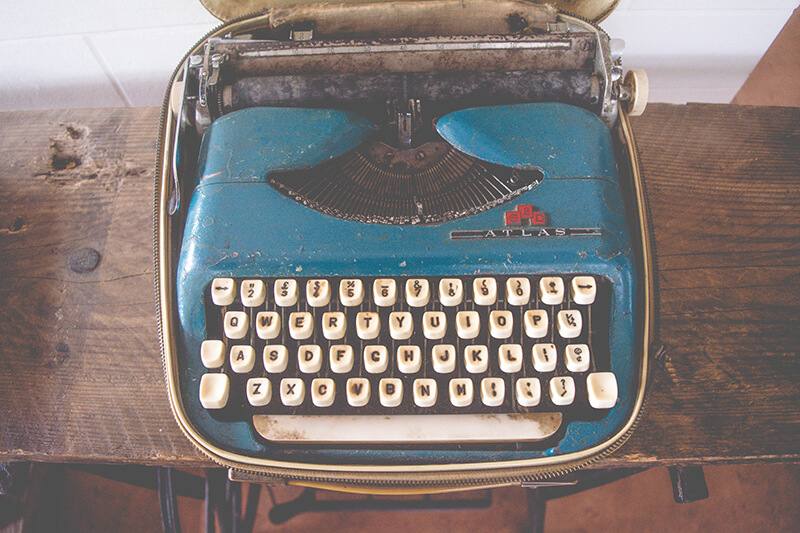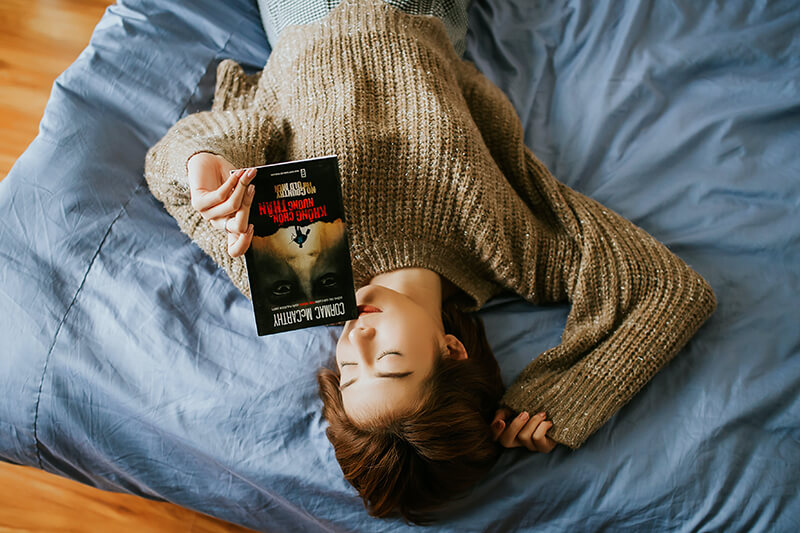
Types of Literary Devices: The Ultimate List (With Examples)
 There are so many types of literary devices in the English language, and if you’re planning on taking any class that covers literature, you’re going to need to know at least the more common ones.
There are so many types of literary devices in the English language, and if you’re planning on taking any class that covers literature, you’re going to need to know at least the more common ones.
Literary techniques are what set the great writers apart from the crowd. The most classic writers who have penned the most iconic pieces of literature are masters of these devices and techniques, and those techniques are the key to what makes their work so prominent even centuries later. There’s a reason we are still studying Ernest Hemingway, William Shakespeare, Jane Austen, and William Faulkner long after they’ve left this earth.
When you take any class that might cover any type of literature, including books, film, and children’s stories, you’re undoubtedly going to have to write a literary analysis, expository essay, or research paper at some point in time. That’s when you’re going to want to turn to this list of literary devices to reference and include in your paper.
Understanding what the different types of literary devices are and how they’re used can not only help you analyze literature in school, but it will also help you become a stronger writer. If learning how to improve your writing skills is something you need to work on, you’re going to want to make sure you learn how to use as many literary elements and techniques as possible.

What Are Literary Devices in English?
Literary devices, or literary techniques, are tools that writers and authors use to convey a deeper theme, meaning, or effect in their writing. They go beyond simply the words written on a page and bring life, depth, and vision to a work. Essentially, in the most simple terms, a literary device is a way that a writer writes something for a specific reason, such as to make a point.
Whenever you write an analytical essay on a piece of literature, such as a book, film, play, or poem, or even a book report, you’ll need to be able to identify the literary devices that are being used and why they’re there. These literary techniques are the key to how those writers get their point across and create powerful themes, concepts, and meanings within their work. Further, they apply to almost any medium, so whether you’re taking a literature class, a film class, or even an English class, you’ll come across them sooner rather than later.
Further, if you’re writing something yourself, you’ll want to pull some of the literary devices from this list in order to strengthen your own writing. Without at least one or two of these techniques, your writing may not get its chance to shine as bright in the ranks of the classics.
The 25 Most Common Types of Literary Devices
We’re going to go over all of these different literary devices in detail, but here’s a quick list of the 25 most common literary devices you’re likely going to see in and out of your academic career.
1. Allegory
2. Diction
3. Alliteration
4. Similes
5. Metaphors
6. Hyperbole
7. Imagery
8. Irony
9. Onomatopeia
10. Allusion
11. Anaphora
12. Juxtaposition
13. Foreshadowing
14. Symbolism
15. Personification
16. Anthropomorphism
17. Satire
18. Motifs
19. Analogies
20. Humour
21. Flashbacks
22. Anastrophe
23. Colloquialism
24. Euphemism
25. In Medias Res

Allegory
The term “allegory” comes from the Latin term “allegoria,” which means, “to imply something else.” In literature, allegory refers to a hidden meaning within a story – kind of like a story within a story. For example, on the surface a story might be about a knight and his quest to slay a dragon to rescue a princess, but the allegory might be a deeper message about chivalry and gender roles.
Typically, when writers use allegory, it’s combined with other types of literary devices, most commonly with symbolism. This creates a deeper meaning and allows the reader to better understand the context.
Here are some examples of allegory in practice:
● George Orwell’s Animal Farm: This classic novella tells the story of a group of animals divided into societal hierarchies on a farm and uses allegory to portray a parallel with the Russian Revolution and communism in the 20th century.
● “The Boy Who Cried Wolf” in Aesop’s Fables: A well-known example of allegory, this classic tale tells the story of a boy who lies about spotting a wolf in the village so many times that no one believes him when there actually is a wolf. The hidden message is about trust, and that by pushing the truth or lying too many times, you could ruin your own credibility and honour.
Diction
It’s a little difficult grasp right away, but diction is a literary device that’s used to describe a writer’s specific choice of words. This may be done through vocabulary choices or through a particular style of writing in order to make a certain point or express a tone. Diction is commonly used in poetry, but occurs throughout a variety of different types of literature.
A writer uses diction in order to convey a specific tone, atmosphere, flow, or voice. It’s also an effective way to utilize expression and emotion, while defining a specific character’s personality or behavioural traits. For example, a writer might use a specific type of slang to convey a particular character’s style or vibe. Therefore, this is a very helpful literary technique to know if you have to write a character analysis essay.
To give you a better idea of how it works, here are some examples of diction:
● John Steinbeck’s Of Mice and Men: The two main characters in this novella, Lennie and George, are simple migrant farm workers with little to no education, and Steinbeck uses diction to convey their status through the way they speak. Here’s one of the more well-known lines said by Lennie: “It ain’t no lie. We’re gonna do it. Gonna get a little place an’ live on the fatta the lan’.”
● Harper Lee’s To Kill a Mockingbird: This novel contains many effective uses of diction in the contrast between the way different types of characters talk. Here’s a line spoken by Atticus Finch, an intelligent lawyer: “The one thing that doesn’t abide by majority rule is a person’s conscience.” Now, here’s a line spoken by his son, Jem Finch, a young child: “You can choose your friends but you sho’ can’t choose your family, an’ they’re still kin to you no matter whether you acknowledge ’em or not.” There is a clear contrast here in diction between the smart, intelligent lawyer and his young child, done purposely to make their dialogue believable and relevant to each person.

Alliteration
A commonly used rhetorical technique, alliteration is a literary element that involves repeating the same sounds or syllables in words that are close together within a sentence or paragraph. This is usually used in poetry for rhyming purposes, but you’ll also likely see it in rhetorical writing like speeches and marketing slogans. With alliteration, the focus is on the sound, and not necessarily the same letters if other letters make a similar sound. For example, “Kelly’s cookies” is alliteration because the K and C make the same sound, but “phony people” isn’t because both Ps make different sounds.
The purpose of alliteration is to make the writing memorable, emphasize a certain tone or point, and/or to make something more interesting. Many companies and corporations use alliteration in their names because it helps with brand recognition and familiarity – think Dunkin’ Donuts, Coca Cola, Krispy Kreme, and American Airlines.
In addition to strengthening writing, alliteration is a great tool to use when you’re learning the English language or warming up before public speaking. Reciting some tongue twisters can help you practice pronouncing and learning syllables and sounds, warm up your tongue for speaking, and help you better enunciate words.
Here are some examples of alliteration in practice:
● She sells seashells by the seashore.
● Don’t make a mountain out of a molehill, Sarah.
● Leo’s lizard likes to lounge on the land under the lamp.
● Rudolph the Red-Nosed Reindeer.
● Becca was busy baking bread for Billy’s baseball team’s bake sale.
● If you can move those blocks, we’ll be right as rain.
● Can you stop the cat from clawing the curtains? It’s causing clumps of clutter.
Similes
One of the most common types of literary devices, similes are used to make writing more descriptive or interesting. It’s a figure of speech that makes a direct comparison between two things using “like,” “so,” “than,” or “as.” Typically, the two things being compared in similes are very different in order to make a point or emphasize something. For example, if you say that something “feels like it’s as tall as a skyscraper,” it’s not actually that tall but you’re making the comparison to get the point across.
The following list features basic examples of similes:
● She was as busy as a bee when I saw her at work today.
● Molly came in from the backyard with her cheeks as rosy as the flowers on the kitchen table.
● Her eyes shine brighter than the sun.
● As she stood on the curb, Shannon looked like she was taller than a giant.
● Waiting for the pot to boil felt as dull as watching grass grow.
● My dad is as strong as an ox.
● Mike and his girlfriend are always fighting like cats and dogs.
● As we took off into the sky, the airplane soared like an eagle over the clouds.

Metaphors
A metaphor is a direct comparison between two things. Usually those two things are unrelated, which gives the reader a more descriptive idea of the topic at hand. Most of the time metaphors aren’t meant to be taken literally. For example, a sports writer might describe Wayne Gretzky as the god of hockey. He’s not literally a god, but he seems this way due to his prominence in the hockey world.
Metaphors serve a similar purpose to similes, in that they’re used to make writing more descriptive and interesting or establish a connection with the reader. However, they differ in that they are direct and don’t involve the use of “as,” “like,” “so,” or “than.”
Here is a list with some examples of metaphors:
● The mountain of papers on her desk weren’t going to mark themselves, so she had to get started early.
● As Mike broke up with her, his words cut deeper than a knife into her heart.
● The old oak tree was a giant towering over the rest of the forest.
● Her long, golden hair was a flowing river of beauty.
● I’m the black sheep of my family.
● His eyes were ice cold staring back at her.
Hyperbole
Hyperbole is a literary device that makes exaggerations or overstatements in order to make a point. Think of it as the writer being over-dramatic about something in order to get their point across. That exaggeration isn’t actually true, but it feels that way because of the way the phrase is written.
Take a look at these examples of hyperbole to get a better idea of it:
- My mom is going to kill me if she finds out I skipped class today.
- I’m so hungry I could eat an elephant right now.
- I’ve been waiting for a new Marvel movie for a million years.
- It takes forever to get anywhere in this city now with all the construction zones.
- This bag weighs a ton. Do you have bricks in here or something?
- I feel like I haven’t seen you in forever!

Imagery
Typically, imagery involves the use of descriptive words that often have particular associations. It involves using figurative language to describe something or someone within a text. Metaphors and similes are commonly used with imagery, as well as many other literary devices.
Imagery can be used both literally and figuratively, and often invokes one or more of the senses to sharpen the image of something in the reader’s brain. A writer might appeal to the sight, taste, smell, sound or touch of a noun with vivid imagery to establish a more descriptive world for the reader to imagine.
The following list includes some basic examples of imagery:
● The opening scene of Shakespeare’s Macbeth: This famous scene in Act 1 of Macbeth is packed full of imagery of dark, spooky tones and witchcraft themes to create a dark, grim atmosphere. Take this line, for example: “Fair is foul and fouls is fair: Hover through the fog and filthy air.” (Macbeth 1.1 12-13). All of this imagery is written to make you feel uneasy and anxious for the tragic events that are about to come.
● Charlotte Perkins Gilman’s The Yellow Wallpaper: In this short story, the wallpaper is described as follows: “The color is repellant, almost revolting; a smouldering, unclean yellow, strangely faded by the slow-turning sunlight. It is a dull yet lurid orange in some places, a sickly sulphur tint in others.” Imagery is used here to make you feel disgusted and frustrated, the same way the main character is viewing the wallpaper and her situation.
Irony
Some might argue that irony isn’t actually a literary device. However, the fact is that it is a literary device, but it’s often not used correctly and therefore doesn’t land the way it’s intended. In some cases, irony is confused with sarcasm or dark humour.
Irony is a literary technique in which a writer describes something using the opposite language of what is intended. In other words, what’s there on the surface doesn’t match up with what is actually the case.
There are different types of irony that are used in writing, such as verbal irony, situational irony, and dramatic irony. Verbal irony occurs when a character might say something that’s the opposite of what they meant or intended. This is often conflated with sarcasm. Situational irony occurs when the result of a character’s actions is the opposite of or different than what was intended. Dramatic irony occurs when the audience knows something that the characters don’t, giving that dialogue added significance or meaning.
Examples of the different types of irony include:
● Verbal irony in Annie: In this Broadway musical-turned children’s film, the orphans frequently say, “We love you, Miss Hannigan,” to Miss Hannigan, their awful and mean guardian. They don’t actually love Miss Hannigan as she is very mean to them, so they are using verbal irony.
● Situational irony in L. Frank Baum’s The Wizard of Oz: In this classic story, the Tin Man, Lion, and Scarecrow accompany Dorothy on a treacherous journey to Oz because they believe they are missing a heart, courage, and a brain. However, when they get to meet the Wizard of Oz, they are informed that they each had these body parts the entire time and just didn’t know how to use them.
● Dramatic irony in Shakespeare’s Hamlet: This Shakespearean tragedy includes a heavy use of dramatic irony. For example, we know that Hamlet isn’t actually going mad but is instead pretending to be for a ruse, but his mother and stepfather don’t know that. We also know that his father was murdered, while many characters don’t. All of that comes into play as the tragedy unfolds and people make misinformed decisions.
Onomatopoeia
Despite its intimidating and complicated name, onomatopoeia is by far one of the most fun literary devices out there. An onomatopoeia refers to words that describe the sound something makes. Usually, you’ll see it in italics in text in order to emphasize the sound. This literary technique is very popular in comic books and graphic novels, but can be used in almost any type of descriptive writing.
Using an onomatopoeia is a great way for writers to give readers more context into sounds because you can’t exactly read a sound. This way, the reader gets a very clear picture in their head and can visualize what’s happening in the story.
This list will give you some examples of onomatopoeia:
● Bang
● Boom
● Splat
● Whoosh
● Creak
● Rip
● Ding dong
● Tick tock
● Gurgle
Allusion
Allusion occurs when a writer makes a reference to something else – usually this is another piece of literature or a classic story. The reference may be direct or indirect, in the form of a phrase or just one word, and typically points to a common or well-known work.
One of the most common and frequent works used in allusion is the Bible. Many of the words you might see in a piece of literature have originated from the Bible, such as the term “good Samaritan” or a reference to the Garden of Eden, the Devil, or even describing an ideal location as “Heaven.”
Some other non-Biblical examples of allusion include:
● Stating that someone has a “Mona Lisa smile” refers to the famous Leonardo DaVinci painting.
● The phrase “if the shoe fits, wear it” comes from a piece of literature written by Richard Hooker in 1593 titled “Of the Lawes of Ecclesiasticall Politie.”
● Saying something is someone’s “kryptonite” is an allusion to Superman and his only weakness, kryptonite.
● When someone refers to a bad idea as “opening up Pandora’s box,” they are alluding to a well-known object in Greek mythology. It was a box given to Pandora that, when opened, would unleash devastating curses on all of mankind.

Anaphora
Commonly used in poetry and rhetorical writing, anaphora essentially refers to the use of repetition of the same words at the beginning of multiple sentences. It might seem similar to alliteration, but there is a difference – alliteration is the repetition of similar sounds, while anaphora is the repetition of the exact same words. Further, anaphora usually occurs at the beginning of sentences.
Anaphora is used to invoke strong emotions and feelings in the reader or audience by emphasizing the repeated phrase or word. This is why it’s often used in rhetorical writing like speeches and motivational TED talks, as well as in poems and songs.
Here are some examples of anaphora in use:
● Martin Luther King, Jr.’s “I Have a Dream” speech: In this famous speech, King, Jr. uses anaphora by repeating multiple phrases that begin with “I have a dream.” He does this in order to appeal to the emotions and passions during the midst of the hardships of the Civil Rights Movement.
● Winston Churchill’s “We Shall Fight on the Beaches” speech: In this speech, Churchill uses anaphora in repeating the words “we shall” at the beginning of each phrase or sentence segment. This is done because at the time he delivered this speech, in 1940, he was trying to encourage the English troops during World War II and restore their faith in achieving victory over the Nazis.
Juxtaposition
Essentially, juxtaposition is a contrast. It occurs when two things that have contrasting ideas or meanings are placed next to one another in a phrase, set of prose, or sentence. This is often done to provoke thought or feelings in the audience, or to create a sense of irony. The two ideas or objects don’t necessarily have to be opposites to create the effect of juxtaposition, but they do have to have some kind of big contrast.
Here are some examples of juxtaposition:
● Charles Dickens’ A Tale of Two Cities: The opening line of Dickens’ novel reads, “It was the best of times, it was the worst of times.” In this line, Dickens is pointing to the drastic class and wealth differences in the pre-French Revolution society, showcasing the fact that while the rich were living their best lives, at the same time the poor in that same society were not.
● Shakespeare’s Othello: In Othello, Shakespeare uses juxtaposition in many instances, but one of the most obvious uses is the contrast between Othello himself and his wife, Desdemona. Othello is often described in association with darker colours and tones, such as when Iago calls him, “an old black ram,” while Desdemona is typically associated with lighter colours. Iago refers to her as a “white ewe.” This is done in order to showcase the fact that Desdemona is pure and innocent, while Othello is dark and capable of terrible things (that will occur later in the play).
Foreshadowing
One of the more common types of literary devices used in dramatic literature and plays, foreshadowing occurs when the writer hints at something that’s going to happen later on in the story. It’s almost like an advanced warning.
Foreshadowing is a signature technique used by William Shakespeare in his tragedies. It can be done subtly through the use of symbolism or imagery, or in more obvious ways right in the text. For example, a character might outright say, “I don’t have a good feeling about this,” or it could be shown through symbolism such as a crow circling around a group of lost travellers.
Here are some examples of foreshadowing:
● The prologue of Shakespeare’s Romeo and Juliet: “From forth the fatal loins of these two foes/ A pair of star-cross’d lovers take their life” (Prologue, Romeo and Juliet, 5-6). In these two lines, the narrator tells us right off the bat that our two main characters, the star-crossed lovers, will kill themselves. We don’t know how, or when, or why – but we know it’s coming, and it keeps the audience reading in anticipation.
● James Cameron’s Titanic (1997): While this film is based on an actual historical event, so most people already know what’s going to happen, the movie itself is filled with uses of foreshadowing. The ship is frequently referred to as “unsinkable,” to the point where it becomes questionable. Further, when Rose arrives on the ship, she remarks that there aren’t enough lifeboats for everyone on board. Both of these examples foreshadow the tragic events that are about to occur when the ship hits an iceberg and sinks.
Symbolism
Like many of the other literary devices and techniques on this list, symbolism is used to convey a deeper meaning in a piece of literature. Symbolism utilizes objects and ideas to represent something else, like a deeper meaning or a concept. For example, in the Star Wars films, Luke Skywalker has a green lightsaber to represent good, while Darth Vader has a red lightsaber to represent evil.
You can find examples of symbolism in almost any aspect of your life – not just in the literature you consume. When you get married, your wedding ring is a symbol of your love and the commitment you’ve made to your partner.
Here are some common examples of symbolism:
● A snake to represent something evil.
● Crows to represent that death is in the near future.
● An empty room to represent loneliness.
● Purple colours to represent royalty.
● Black colours to represent evil, sin, or death.
● A light bulb to represent an idea.
● Roses to represent love.
● A lion to represent courage.
Personification
Personification occurs when a writer gives human attributes or characteristics to a non-human or inanimate object within a description. This technique is used to establish an emotional connection between the reader and the object, usually to spark empathy or make the reader feel a certain way.
Here are some basic examples of personification:
● The reflection of the flames from the fire danced along the cave wall.
● Mike’s old rusty car coughed and heaved as it pushed its way up the steep hill.
● His tired, beaten up work shoes had clearly seen better days.
● The wind whistled in my ears like an old show tune I couldn’t get out of my head.
● Jessica, that last piece of pizza is calling your name.
● My alarm clock was screaming at me as I struggled to wake up that early in the morning.
Anthropomorphism
An anthropomorphism is a literary technique in which inanimate or non-human objects or animals behave like humans or take on characteristics that humans have. This is a very common literary device used in children’s stories, fairy tales, animated movies, and fables.
Anthropomorphisms are often confused with personification because they are relatively similar types of literary devices. However, there are a few key differences between the two. With personification, non-human or inanimate objects are described with human-like attributes. However, with anthromorphisms, the non-human objects actually take on human characteristics and behave like humans.
Examples of anthropomorphism include:
● Disney’s Beauty and the Beast (1991): In Beauty and the Beast, many of the household items in the Beast’s castle can talk, move, and interact with Belle and each other just like humans would. Characters such as Chip, Mrs. Potts, Cogsworth, and Lumiere are all examples of anthropomorphism.
● George Orwell’s Animal Farm: In addition to its use of allegory, Animal Farm is also a great example of anthropomorphism. All of the animals on the farm in the story are sentient beings who talk and act like humans, creating a societal hierarchy where the pigs are at the top.
● Pixar’s Toy Story franchise: In all of the movies in the Toy Story franchise, the toys come alive once all humans have left the room. Each toy experiences emotions, can talk, and is mobile enough to move around and escape from Andy’s room.
Satire
Satire is commonly used to make commentary on something in the world, whether it occurred in the past or in the present day. Most of the time, this commentary is meant to criticize something such as a society, government, political or social issue, an ideology, or a person.
In order to get the point across, satire is typically combined with other literary devices, most commonly with irony, imagery, humour, and/or hyperbole. There are also various forms of satire you may come across, such as parodies and jokes.
Writing satire can be incredibly difficult because it often requires your writing to be very smart, strategic, and witty. If you don’t write satire properly, your audience or reader will miss the point entirely and get the wrong message from your work.
To give you a better idea, here are some examples of successful satire:
● The Onion: One of the most well-known satirical publications out there, The Onion is an online digital newspaper that publishes completely fake, parody-style articles that offer a satire on the world’s news and current events. In publishing these parody news articles, the newspaper makes a commentary on many aspects of the world either to point out the irony of certain things or to highlight right and wrong.
● Saturday Night Live: Many of the skits on this long-running sketch show are parodies and satires of current events. They are often done in a mocking fashion in order to make a point about something in the world, and they utilize satire efficiently to entertain the audience.
● Jane Austen’s Pride and Prejudice: Austen’s most well-known work is a satire on the Victorian society in which she lived. She makes many points about class divisions, marriage expectations, and gender roles in her time and uses the story to showcase the issues with these societal rules.
Motifs
The term “motif” is French and translates directly to “pattern.” As a literary device, a motif is a repeating symbol, idea, or object that is mentioned throughout the work. Motifs are used to uphold a particular theme or connect an idea or tone, or point out a certain theme that’s important to the meaning of the story. Ultimately, it’s used to show the significance of something.
Here are some examples of motifs in literature:
● Edgar Allan Poe’s The Tell-Tale Heart: In this short story, the narrator commits a murder and repeatedly hears his victim’s heart beating long after he is dead. The heartbeat is used to represent the narrator’s guilt, and as it becomes louder the narrator begins to lose his sanity and become overwhelmed with guilt.
● Shakespeare’s Macbeth: In this famous tragedy, blood is used as a motif to showcase Lady Macbeth’s guilt and descent into madness after she convinces her husband to kill King Duncan. She begins to see blood all over her skin, and no matter how hard she scrubs, it won’t come off because her guilt is growing stronger. The blood continues to appear in her nightmares and hallucinations because she is going mad, and eventually she succumbs to this madness by killing herself. Blood is also used as a motif for Macbeth, as he begins to see the blood-soaked dagger he used to kill Duncan following him around.
Analogies
An analogy is a comparison between two things. In general, it’s common to use an analogy to provide an example of something or explain something in a way the reader or listener can relate to. As a literary device, analogies are usually used to make connections between things or concepts, show the significance of something, or emphasize something. They are commonly seen in poetry and prose.
Examples of analogies include:
● Proverbs 25:25: “As cold waters to a thirsty soul, so is good news from a far country.” This Bible verse makes an analogy using the relieving feeling of quenching your thirst after being parched as a way to explain the feeling of getting good news you’ve been waiting for.
● Robert Zemeckis’ Forrest Gump (1994): The most famous line from this film is, “Life is like a box of chocolates – you never know what you’re gonna get.” This is an analogy to explain how life is full of mysteries and unexpected twists, and that you can’t predict how the future will go.
● Harper Lee’s To Kill a Mockingbird: Toward the end of the novel, we find out that the mockingbird is actually an analogy for the concept of innocence. Killing a mockingbird is just like killing something innocent, much like the way that Tom Robinson is wrongfully accused or Boo Radley is wrongfully judged by society.
Humour
By definition, humour is a literary device used to make the audience laugh, or at the very least amuse them. It’s often used to soften up a piece of writing, or to provide entertainment within a literary text. Even if a line just makes you chuckle a little bit, the writer has done their job.
Humour is one of the most versatile types of literary devices because it can apply to almost any medium. However, it’s important to be careful when writing humour. You need to make sure you’re using it in the right context and that it’s going to be something that will actually get a reaction out of your audience. Typically, writers will use a combination of different literary techniques to achieve humour, such as hyperbole, metaphors, and imagery.
Here are some examples of humour used in classic literature:
● Jane Austen’s Pride and Prejudice: While the entire novel is humorous, you can see a clear example of Austen’s use of humour in this line, spoken to Mrs. Bennet by Mr. Bennet as Mrs. Bennet is complaining about her nerves: “You mistake me, my dear. I have a high respect for your nerves. They are my old friends. I have heard you mention them with consideration these twenty years at least.”
● Roald Dahl’s poem “Cinderella”: This poem is a retelling of the story of Cinderella in a humorous, silly way that appeals to younger audiences. Dahl refers to Cinderella as “Cindy,” and the evil stepsisters as the “Ugly Sisters.” He also describes Cindy as “locked up in a slimy cellar,/ Where rats who wanted things to eat,/ Began to nibble at her feet” (Dahl, “Cinderella,” 12-14).

Flashbacks
Flashbacks occur when the writer jumps back in time or describes something that happened in the past. It could be something that already happened in the story itself, or an event that took place before the timeline of the story.
Most people know what a flashback is because you’ll see them in various areas of popular culture, from movies to television shows and everything in between. However, flashbacks are also used as a literary device to add more context to a story, or give the reader more details that impact the meaning of the story. It’s also a great way to provide more insight into a particular character’s personality or explain why they act the way they do.
Some famous examples of flashbacks in literature include:
● J.K. Rowling’s Harry Potter and the Chamber of Secrets: In the second book of the Harry Potter series, Harry experiences a flashback that shows a young Tom Riddle (future Voldemort) when he was a student at Hogwarts School of Witchcraft and Wizardry. This is done in order to add context and give some background as to why Voldemort became as evil as he is.
● F. Scott Fitzgerald’s The Great Gatsby: In the opening scene of this novel, Fitzgerald begins with a flashback wherein the narrator, Nick Carraway, rehashes some old advice his father gave him when he was younger. This is done in order to add some context to the story and kick off the theme of the book.
Anastrophe
While it’s a less common literary technique you won’t see as often, anastrophe is a figure of speech where the words within a phrase are inverted or reversed. For example, instead of subject-verb-object, you might see a phrase written as object-subject-verb.
You may be wondering why anyone would want to use this complicated and tedious literary device that essentially throws the entire context of English syntax on its head. However, there are valid reasons to use it. Most commonly, poets often use anastrophe in their poetry and verse to maintain a particular rhyming scheme. It can also be used to create emphasis or meaning within a phrase because anastrophe forces the audience or the reader to pay attention to what the character is saying or what the text says.
The most famous example of anastrophe is the character Yoda from the Star Wars franchise. Almost everything Yoda says is an anastrophe. Take a look at some of his famous quotes: “Patience you must have, my young Padawan.” “Powerful you have become; the dark side I sense in you.”
Colloquialisms
A colloquialism is an informal or casual word, phrase, or expression that is used in everyday speech, such as slang. Writers typically use colloquialisms in dialogue to make what the characters are saying more believable or realistic, or to showcase their personality. For example, a blue collar, uneducated factory worker isn’t going to speak the same way as a formal physics professor with multiple PhDs, so the dialogue for each character should reflect that.
meta
Here are some basic examples of colloquialisms:
● Why are you feeling so blue today, Maggie?
● Bugger off, John. I don’t care about your football team.
● What’s up, Joey?
● I’m really digging the vibe in this room. Let’s stay for a bit.
● Well, I think it’s about time to hit the hay. I’m exhausted.
● Those are some sick beats!
Euphemism
You will often hear euphemisms used to describe or make reference to something inappropriate, indecent, rude, or otherwise unpleasant. They are used when the writer or character wants to avoid saying the actual term. Most of the time we think of euphemisms as ways to refer to something with mature or adult content, but they can also be used for generally uncomfortable topics such as death, or gross topics such as bodily functions.
Here is a list of some common examples of euphemisms:
● “Before I go” in place of “before I die.”
● “Passing gas” to describe flatulence (farting).
● “He has a screw loose” to describe someone who is dumb or stupid.
● “He didn’t make it” is a term doctors usually use when telling the family of a deceased patient that their loved one has died.
In Medias Res
Last but not least, we have in medias res, also known as an action prologue. From Latin, “in medias res” translates to “in the middle of things.”
While the name might throw you off a little bit, you’ve almost certainly seen this in use in books, movies, or television shows. In medias res is a literary technique where the narrative opens right in the middle of a crucial point in the plot. Essentially, when you open the first page of the book, you’re immediately thrown into the action. You may get a little more contact through flashbacks or dialogue, but the plot is already well underway when you start reading.
There are a few different reasons a writer might use in medias res. Firstly, for an epic or tragic piece, this helps capture the audience’s attention as they become invested in or hooked on the story. Secondly, it’s a great way to skip over less interesting details to get closer to the action.
Here are some examples of in medias res:
● William Shakespeare’s Hamlet: In Hamlet, we are immediately thrown into the action in the very first scene because the play begins shortly after Hamlet’s father has died. We learn about the murder as the rest of the plot unfolds through dialogue.
● Tim Miller’s Deadpool (2006): The opening scene of this superhero film throws the audience right into the middle of a chaotic fight scene, with no context until Deadpool begins to turn to the camera and explain what’s happening. We later learn how all of this action is connected, but it serves the purpose of capturing the audience’s attention right away in the first few minutes of the film.
How do You Identify a Literary Device?
We’ve gone over the most common types of literary devices you may encounter in pieces of literature, popular culture, or in other forms of storytelling. Now, it’s time to make use of this knowledge and learn how you identify a literary device.
Here are four steps to follow that will help you identify common literary devices while you’re analyzing a text or writing an expository essay on a piece of literature:
1. Study this list of literary devices and spend a bit of time trying to memorize them. This will help you recognize one right away when you see it.
2. Determine who the author’s intended audience is and the type of work it is. Some literary devices are more common in certain types of work – for example, anthromorphism is more common in children’s literature, while anaphora is more common in speeches and poetry. It’s good to have an idea of which ones you’re going to be on the lookout for so you can get your brain to focus on those elements.
3. Read the text carefully and don’t skip or skim anything. Pay attention to how you feel or react to various passages or sentences. If something provokes a response in you, that’s a good sign you just encountered a literary device.
4. Take notes as you read and use sticky notes to mark places where you find anything that could be a potential literary technique. You can go back later and dig a little deeper or refer back to this list.

Too Many Types of Literary Devices, So Little Time: Avoid The Effort With Professional Help
There are so many different literary devices out there that this list doesn’t even cover. In fact, there are so many that it can be incredibly confusing and frustrating to try and keep track of all of them. The good news is that you don’t have to – there are options out there that allow you to bypass this tedious process entirely.
Our team of academic writers and scholars includes English, arts, and humanities majors and experts who have studied, written, and analyzed literature throughout their careers. Whether you’re writing a book report for your English literature class or need to write an expository essay on a piece of American literature, we’re here to help. Let us take care of your assignments for you so you never miss a key literary device or story element.
Order your literature essay, research paper, or literature review now with our easy online ordering system, or fill out a form to get a free custom quote from our operations team.
Share:

